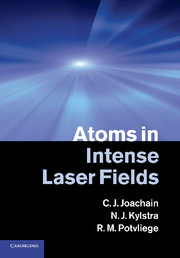Book contents
- Frontmatter
- Contents
- Preface
- Part I Basic concepts
- Part II Theoretical methods
- 3 Perturbation theory
- 4 Floquet theory
- 5 Numerical integration of the wave equations
- 6 The low-frequency regime
- 7 The high-frequency regime
- Part III Multiphoton atomic physics
- Appendix: Atomic units and conversion factors
- Author index
- Subject index
- References
5 - Numerical integration of the wave equations
Published online by Cambridge University Press: 05 January 2012
- Frontmatter
- Contents
- Preface
- Part I Basic concepts
- Part II Theoretical methods
- 3 Perturbation theory
- 4 Floquet theory
- 5 Numerical integration of the wave equations
- 6 The low-frequency regime
- 7 The high-frequency regime
- Part III Multiphoton atomic physics
- Appendix: Atomic units and conversion factors
- Author index
- Subject index
- References
Summary
One of the major non-perturbative methods used to study atoms in intense laser fields is the direct numerical integration of the wave equations describing atoms interacting with laser fields [1]. This is an attractive alternative to the methods discussed in the two preceding chapters, since solutions of the wave equations can be obtained by numerical integration for a wide range of laser intensities and frequencies. In addition, no restrictions need to be imposed on the type of laser pulses which are used, making the numerical integration of wave equations particularly useful for the study of interaction of atoms with short laser pulses.
However, the numerical integration of the wave equations is computationally very intensive, for the following reasons. Firstly, at high laser intensities, and especially for low frequencies, the ionized electrons can acquire quite high velocities and their quiver motion becomes much larger than the size of the initial atomic orbit. The corresponding wave packets can therefore travel large distances in short time intervals. As a result, the spatial grids used to follow the motion of these wave packets must be large and have small spatial separations. Secondly, the discretization of time, used in all numerical integration schemes, requires a large number of small steps in order to obtain accurate results. Thirdly, the direct numerical integration of the wave equations becomes extremely demanding for atoms with more than one active electron.
Information
- Type
- Chapter
- Information
- Atoms in Intense Laser Fields , pp. 218 - 266Publisher: Cambridge University PressPrint publication year: 2011
